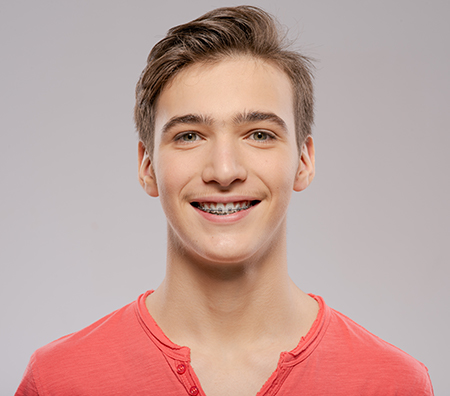North Haven Office

Our Offices
41 Middletown Ave
North Haven, CT 06473
Existing Patients: (203) 234-3900
New Patients: (203) 309-2799
Cromwell Office

Orthodontic care today blends precise biomechanics with individualized planning to create lasting improvements in how teeth look and function. Treatment begins with a careful evaluation of tooth positions, jaw relationships, and how the bite performs during everyday activities like chewing and speaking. That assessment guides a treatment plan tailored to your goals — whether that means correcting crowding, closing spaces, or addressing bite imbalances that affect comfort and long-term dental health.
Appliances used in contemporary orthodontics are designed to move teeth gently and predictably. Traditional metal brackets remain a reliable option, but they are now smaller, more comfortable, and easier to maintain. For many patients there are alternative systems — such as ceramic brackets, lingual braces placed behind the teeth, or removable clear aligners — that offer different blends of visibility, convenience, and control. The choice of appliance is driven by clinical need and personal preference.
Treatment timelines vary because every mouth is unique. Some cases require only modest tooth movement and can be completed in months, while more involved corrections that include jaw relationships or severe crowding can take longer and may involve staged care. Throughout treatment, the goal is steady, healthy change — using forces that encourage the supporting tissues to adapt without damage.
We take a holistic view of each smile, looking beyond isolated tooth position to the way your teeth, gums, and jaws work together. At Nova Dental, that means combining clinical judgment with modern tools so you get results that are stable, functional, and aligned with your expectations.
A straight smile is often thought of as an aesthetic asset, but alignment influences much more than appearance. Properly aligned teeth distribute biting forces evenly, reduce unusual wear, and make daily cleaning more effective. When teeth and jaws work together as they should, people experience fewer functional problems and better oral resilience over time.
Malaligned teeth and poor bite relationships can lead to a cascade of issues: food traps that increase decay risk, uneven tooth wear, and muscle or joint strain around the jaw. In some cases, misalignment contributes to chronic discomfort such as headaches, jaw pain, or difficulty opening and closing the mouth. Treating these root mechanical issues often improves both comfort and long-term oral health.
Orthodontic care is preventive as well as corrective: when teeth are guided into healthier positions early, it can reduce the likelihood of future dental complications. For adults, correction can relieve longstanding problems that developed over years and restore the ability to maintain healthier teeth and gums.
Cleaning is easier when teeth are aligned, which lowers the chance of decay and inflammation around the gums.
Teeth properly covered by the lips and cheeks are less exposed to accidental trauma and wear.
Correct alignment supports efficient chewing and clearer speech by letting the jaws and teeth work in harmony.
Uniform contact between teeth helps prevent localized overloading that causes chips, cracks, and rapid wear.
A balanced bite reduces strain on the temporomandibular joints and surrounding muscles, which can lower the risk of jaw-related pain.
Because oral health affects whole-body wellness, maintaining proper alignment contributes to overall quality of life.

Selecting an appliance is a partnership between the clinician’s recommendation and the patient’s priorities. Some people prioritize the fastest, most controlled tooth movement; others favor a discreet, low‑profile option that fits their lifestyle. During a consultation we explain the strengths and limitations of each approach and match the method to the case objectives.
Children and adolescents often benefit from timing their treatment to take advantage of growth, while adults frequently choose options that integrate with demanding schedules and professional life. Regardless of age, the clinician evaluates the severity of the bite discrepancy, the position of individual teeth, and the health of the gums and supporting bone before recommending a path forward.
Adherence also matters: removable appliances and clear aligners depend on consistent wear to produce the intended result. Fixed appliances require good oral hygiene and periodic visits for adjustments. Your lifestyle, level of motivation, and clinical needs all play a role in choosing the ideal system.
How severe the bite problem is and whether jaw relationships must be changed
The amount of crowding or spacing between teeth
Whether any tooth removals or preparatory dental work are needed
The alignment between the upper and lower jaws and how teeth come together
Estimated duration of appliance wear and the patient’s preferences about visibility
Any need for supplemental appliances to guide growth or provide temporary anchorage
Patient commitment to oral hygiene and appliance care during treatment

Orthodontics has evolved rapidly, and today’s clinicians use a mix of digital imaging, computer planning, and refined hardware to plan and execute treatment more predictably. These advances help tailor force application, reduce unwanted movement, and create workflows that are more comfortable for patients.
Three-dimensional imaging and intraoral scanning provide clearer diagnostics and eliminate much of the guesswork of older approaches. Digital models let clinicians simulate outcomes and communicate treatment steps in a way that patients can easily understand. This clarity enhances planning and helps set realistic timelines.
At the same time, bracket design and materials have improved. Smaller brackets and smoother archwires enhance comfort, and innovations such as self-ligating brackets can reduce friction. When indicated, temporary anchorage devices (TADs) and accelerated techniques are options to achieve specific movements more efficiently.
Low-profile metal brackets and tooth-colored ceramic options for improved comfort and appearance
Custom clear aligner systems that move teeth incrementally while remaining nearly invisible
Lingual appliances mounted behind the teeth for patients seeking minimal front‑visible hardware
Digital impressions and 3‑D treatment planning that enhance precision and patient communication
Temporary anchorage devices (TADs) and other adjuncts to achieve complex tooth movements
Techniques to reduce treatment time when clinically appropriate, combined with thoughtful maintenance
Clear aligners have opened new possibilities for patients who want effective tooth movement without visible brackets and wires. Custom-made trays fit over the teeth and are changed on a programmed schedule to advance the smile step by step. Because aligners are removable, they make oral hygiene simpler and allow patients to eat without the food restrictions that come with fixed braces.
Aligner therapy is an excellent option for many mild-to-moderate corrections and is increasingly being combined with other orthodontic tools when needed. It requires consistent wear and periodic monitoring to track progress and make refinements. For some complex bite issues, fixed appliances or a hybrid approach may achieve the most predictable result.
Our team stays current with technological advances so we can recommend the right blend of tools for each case. Where clear aligners are suitable, we present them as one of several clinically accepted paths toward a healthy, functional result.

Removing appliances is a milestone, but preservation is an equally important phase. Teeth have natural tendencies to shift over time, and retainers are the primary tool to hold the new positions steady while tissues settle. The form of retainer — removable, fixed, or a combination — is selected based on the case and long-term needs.
Long-term stability depends on more than retainers alone. Ongoing attention to oral hygiene, routine dental care, and addressing any habits that affect tooth position will help preserve results. For many patients, occasional check-ins over the years provide reassurance that alignment remains stable and that any minor changes are caught early.
Because every mouth is subject to natural forces and life changes, a practical maintenance plan is part of the original treatment strategy. This forward-looking approach helps ensure that the benefits of care — improved function, easier hygiene, and greater confidence — endure.
Investing effort in retention and routine care protects the time and commitment spent during active treatment, letting you enjoy the functional and aesthetic gains for years to come.
In summary, contemporary orthodontics offers a variety of clinically proven ways to align teeth and optimize bite function, guided by careful diagnosis and modern technology. If you’d like to learn more about which approach might suit your needs, contact us to discuss your options and schedule a personalized consultation.
Most parents wonder when is the best time to have their child evaluated for braces. One common misconception regarding orthodontic treatment is to wait until all of your child's permanent teeth (except the wisdom teeth) are present. However, an orthodontist can identify most problems involving the alignment of the teeth and jaw growth by the time a child is in the first or second grade. For this reason, the American Association of Orthodontists recommends that all children have a check up with an orthodontic specialist no later than age 7.
It is important to keep in mind that aligning the teeth and the jaws does not happen overnight. Whether you are wearing conventional braces, clear aligners, or any other type of appliance, orthodontic movement is a gradual process. Orthodontic tooth movement is based on the use of light and continuous forces to correct your bite in an incremental, predictable, and healthy manner.
The total duration of orthodontic care, not including wearing retainers to maintain the result, depends on several factors. Such things as growth, as well as compliance with care, may influence treatment time. On average comprehensive orthodontic care to correct a malocclusion can take anywhere between 18-36 months. Orthodontic treatment for more limited problems with tooth alignment typically ranges from 6 to 18 months.
Because orthodontic movement takes time, most appointments after the initial placement of appliances are scheduled approximately four to eight weeks apart. This interval gives your teeth time to move at both a steady and healthy pace. However, there may be situations where more frequent visits to evaluate the status of your case, tooth movement, or to have an additional adjustment are required.
Teeth can be moved at any age. Orthodontic treatment as an adult can completely transform an imperfect and poorly aligned smile into one that is attractive and functions at its best. However, initiating orthodontic care and achieving a successful outcome relies on the presence of healthy teeth and supporting bone. For these reasons, it is essential for adult patients to address any outstanding dental problems before their appliances are placed and to remain diligent about maintaining their oral health throughout care.
A comprehensive orthodontic evaluation includes a clinical exam of tooth positions, gum health and jaw relationships, along with diagnostic records such as digital X-rays, photographs and intraoral scans. These records allow the clinician to measure how teeth meet, evaluate airway and facial proportions, and identify any underlying dental conditions that might affect treatment. In many cases the exam also assesses habits and medical history to ensure a safe, personalized plan.
Using this information the clinician develops a treatment plan with clear objectives, timelines and appliance options tailored to the patient’s goals and oral health status. The plan balances functional needs—such as improving bite and chewing—with aesthetic considerations and long-term stability. During the consultation, clinicians explain expected steps and answer questions so patients can make an informed decision.
Choosing between fixed braces and removable clear aligners depends on clinical needs, aesthetic preferences and lifestyle factors. Traditional metal or ceramic braces can provide precise control for complex movements, while aligners are popular for their low visibility and easier oral hygiene. Compliance and daily wear time are critical with aligners because inconsistent use slows progress. The clinician reviews the advantages and limitations of each option to match the appliance to treatment objectives.
At Nova Dental the treatment recommendation always starts with a diagnostic assessment and a discussion of goals, risks and expected outcomes. For cases requiring significant bite correction, fixed appliances or hybrid strategies are often more predictable, whereas mild-to-moderate crowding is frequently well-suited to aligner therapy. Patient preference about visibility, comfort and appointment frequency is considered alongside clinical indications. If necessary, a staged approach combining different tools can provide efficient, stable results.
Treatment length varies widely based on the complexity of the problem, the types of movements required and whether jaw growth needs to be addressed. Simple corrections may take several months, while comprehensive cases involving jaw relationships or extractions can require one to two years or more. Factors such as patient age, biological response to force and adherence to instructions also influence the timetable.
Clinicians monitor progress at regular intervals to confirm teeth are moving as planned and to make any needed refinements to appliances or mechanics. Occasional adjustments or the addition of auxiliary devices can modify the timeline to prioritize stability and health. A clear communication of milestones at the outset helps patients understand when to expect active treatment to end and retention to begin.
Modern orthodontics offers a range of appliances including low-profile metal braces, tooth-colored ceramic brackets, lingual braces mounted behind the teeth and custom clear aligner systems. Auxiliary devices such as springs, elastics and temporary anchorage devices (TADs) are used to achieve particular tooth movements or to provide stable anchors. Retainers—removable or fixed—are essential after active treatment to hold results while tissues adapt. Each appliance has trade-offs in visibility, control and maintenance that clinicians review with patients.
The choice of device is driven by clinical requirements like the severity of crowding, the need to change jaw relationships and the health of supporting bone and gum tissue. For patients with active periodontal concerns or prior dental work, the team tailors mechanics to protect oral health while reaching alignment goals. Good oral hygiene and regular follow-up appointments are important regardless of the appliance selected.
Correcting dental alignment improves more than appearance; it enhances chewing efficiency, distributes bite forces evenly and reduces abnormal wear on teeth. Aligned teeth are easier to clean, which lowers the risk of decay and gum disease over time. Proper alignment can also alleviate muscle strain and reduce the likelihood of jaw-related discomfort in susceptible patients.
Early orthodontic guidance can prevent more severe problems later by directing growth and space management during development. For adults, treating longstanding malocclusions can restore function and simplify restorative work by creating predictable tooth positions. Overall, alignment contributes to oral health, comfort and the long-term success of dental care.
Orthodontic evaluations are appropriate at multiple stages of life and many clinicians recommend an initial check by age 7 to identify emerging problems that may benefit from early guidance. Childhood and adolescent treatment can take advantage of growth to correct skeletal discrepancies more easily than in adulthood. However, there is no upper age limit for orthodontic care, and many adults pursue alignment for health or aesthetic reasons.
Adult treatment emphasizes periodontal health, restorative needs and realistic expectations about movement speed compared with children. Treatment planning for adults often coordinates with other dental specialties to ensure comprehensive care and stable results. The key is a thorough evaluation and a plan that aligns with the patient’s oral health status and goals.
Clear aligner therapy uses a series of custom trays that progressively move teeth according to a digital treatment plan created from scans and models. Each tray applies gentle, controlled forces to selected teeth and is worn for a prescribed number of hours per day before switching to the next in the series. Success depends on consistent wear, accurate fit and regular monitoring to verify that movement follows the plan.
Candidates for aligners typically include patients with mild-to-moderate crowding, spacing or certain bite discrepancies who are committed to wearing trays as directed. Complex skeletal problems or severe tooth rotations may still require fixed appliances or adjunctive procedures for predictable correction. During consultation the clinician evaluates the case and outlines whether aligners alone, a hybrid approach or traditional braces will best meet the desired outcome.
Some soreness or pressure is common after adjustments or when starting a new aligner stage, but this discomfort is generally brief and manageable with over-the-counter pain relievers when appropriate. Fixed appliances can create localized irritation on cheeks or lips until soft tissues adapt, and orthodontic wax can ease these areas. Clear aligners often cause less soft-tissue irritation but still require attention to fit and cleanliness.
Oral hygiene becomes even more important during orthodontic treatment; patients should maintain regular brushing, interdental cleaning and professional checkups to prevent decay and gum inflammation. For fixed appliances, special brushes and flossing aids help clean around brackets and wires, while removable aligners should be cleaned daily and stored hygienically when not in use. The clinical team provides tailored instructions to protect tooth enamel and supporting tissues throughout treatment.
Digital imaging, intraoral scanning and 3-D treatment planning enable clinicians to visualize outcomes, simulate tooth movement and plan precise force applications before treatment begins. These tools reduce uncertainty, improve communication with patients and allow more predictable sequencing of mechanics. When combined with modern bracket designs and auxiliary devices, technology contributes to greater comfort and efficiency.
Nova Dental uses digital workflows to enhance diagnostics, patient education and coordination with other dental specialists when necessary. Electronic records and simulations help the team monitor progress, make data-driven adjustments and set realistic expectations for each phase of care. By blending clinical judgment with technology, the practice aims to deliver safe and reproducible results for a wide range of cases.
Retention begins after active tooth movement and focuses on maintaining the new positions while soft tissues and bone remodel to support them. Retainers can be removable or fixed and are prescribed based on the original condition, the movements achieved and long-term risk of relapse. Wearing retainers as recommended and attending occasional follow-up visits are central to long-term stability.
Retention also offers an opportunity to address minor post-treatment changes early with simple interventions, preserving functional and aesthetic outcomes. Maintaining good oral hygiene and avoiding habits that displace teeth—like nail biting or using teeth as tools—supports retention efforts. A practical, individualized retention plan helps patients protect their investment in treatment and enjoy lasting benefits.
